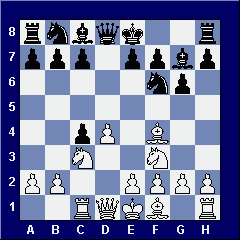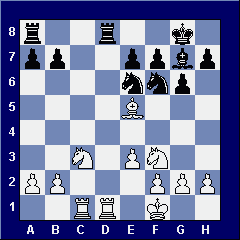|
 Karpov,A
(2688) - Kasparov,G (2836) [D92] Karpov,A
(2688) - Kasparov,G (2836) [D92]
X3D Rapid Match New York City (3), 20.12.2002
1.d4 Nf6 2.c4 g6 3.Nc3 d5 4.Nf3 Bg7 5.Bf4 dxc4 6.Rc1 This
system suits Karpov well, giving him an opportunity to win safely.
The idea of the Rc1 Grunfeld lines is to delay e2-e3, taking the
sting out of black's ...c7-c5 and ...Qa5 ideas, mainly because the
bishop on f4 can still retreat to d2, nullifying all of black's
pressure on the a1-h8 diagonal
 6...0-0
7.e3 Nbd7 6...0-0
7.e3 Nbd7
[ 7...c5 8.Bxc4 cxd4 9.Nxd4 (RR 9.exd4 a6 10.a4 Nc6 11.d5
Nh5 12.Be3 Ne5 13.Be2 Ng4 14.Bd4 e5 15.Bc5 Nf4 16.0-0 e4 17.Nxe4
Re8 18.Ng3 h5 19.Rc4 Bh6 20.h3 h4 21.Nxh4 Ne5 22.Rxf4 Bxf4 23.Nf3
Qf6 Karttunen,M-Luukkonen,T/Jyvaskyla 2001/EXT 2002/0-1 (34))
9...Bd7 10.Nb3 Nc6 11.Nc5 Bc8 12.0-0 Nd7 13.N5e4 Nde5 14.Be2
1/2-1/2 Dreev,A-Smirin,I/Sarajevo 2001/CBM 84 (14)
7...Be6 8.Ng5 Bg4!?N ( 8...Bd5 9.e4 h6 10.exd5 hxg5 11.Bxg5
Nxd5 12.Bxc4 is normal here.) 9.f3 Bc8 10.Bxc4 c6 11.Qb3
e6 12.Nge4 Nd5! 13.Bxd5 cxd5! gave Kasparov a comfortable position
which he went on to win in game one. He didn't repeat this line,
perhaps fearing Karpov's home analysis.]
8.Bxc4 c5N an obvious improvement on the passive 8...c6?!
9.0-0 Nb6 10.Bd3 Nfd5 11.Be5 f6 12.Bg3 Bg4 13.Be2 ( 13.h3!
gives white a very pleasant, risk-free advantage.) 13...Bh6
14.Ne4 Nxe3!? 15.fxe3 Bxe3+ 16.Nf2 Bxf3 17.Qb3+ Nd5 18.Bxf3 Bxc1
19.Rxc1 Qb6 20.Bxd5+ cxd5 21.Qxd5+ e6 22.Qe4 Rad8 23.Bc7 Rc8 24.Bxb6
Rxc1+ 25.Nd1 Rxd1+ 26.Kf2 axb6 27.Qxe6+ Rf7 28.Qxb6 Rd2+ 29.Kf3
Re7 30.Qd8+ Kf7 31.d5 g5 32.d6 1/2-1/2 Green,P-Dunn,M/IECC (email)
1998
9.dxc5! What's this? One would expect a sharp struggle arising
from 9.O-O cd4 10.ed4 +=. But from a psychological standpoint I
think this is a brilliant decision. First, Karpov doesn't want a
sharp struggle. Karpov concedes that he can't match Kasparov's computer-like
analytical skills so he steers for a lifeless technical position
where Kasparov's imagination and calculation abilities don't do
him a lot of good.
Second, I think Karpov is happy with a draw, hoping to hold with
black in the final game and tie the match. Lastly, this is one type
of position where Karpov still holds an advantage over Kasparov.
What follows probably exceeded his hopes in this match.
9...Nxc5 10.0-0 Be6 Ok, this means that Kasparov has clearly
decided that a draw is ok. 11.Bxe6 Nxe6 12.Be5 Qxd1 A strange
decision. Why develop white? 12...Qb6 looks totally equal. 13.Rfxd1
Rfd8 14.Kf1
 14...Nd7?
This innocent looking move lands Kasparov in deep trouble. But
I still think that white would have a microbe of an advantage after
either 14...Kf8 or 14...Rxd1+. If Kasparov has any stylistic weaknesses
at all it would be a position like this, where he is a shade worse
in a lifeless position. Like Alekhine, Kasparov is psychologically
unable to make a passive move like 14...Kf8 or 14...Rxd1+. Instead
he gets active, probably dreaming of ...Nc5 and ...Nd3 at some future
point. 14...Nd7?
This innocent looking move lands Kasparov in deep trouble. But
I still think that white would have a microbe of an advantage after
either 14...Kf8 or 14...Rxd1+. If Kasparov has any stylistic weaknesses
at all it would be a position like this, where he is a shade worse
in a lifeless position. Like Alekhine, Kasparov is psychologically
unable to make a passive move like 14...Kf8 or 14...Rxd1+. Instead
he gets active, probably dreaming of ...Nc5 and ...Nd3 at some future
point.
15.Bxg7 Kxg7 16.Nd5! Nb6 A forced move. [ 16...Kf8??
17.Nc7! wins.] 17.Nxb6 axb6 18.a3 Rxd1+ 19.Rxd1 Rc8 20.Ke2 White
has a technically won game. The b6 pawn is a permanent target. White's
plan should be to trade rooks. In a knight endgame the white king
would constantly threaten to stroll over to b5. I think it was Bronstein
who once said that all knight endgames are really king and pawn
endgames. 20...Kf6
|